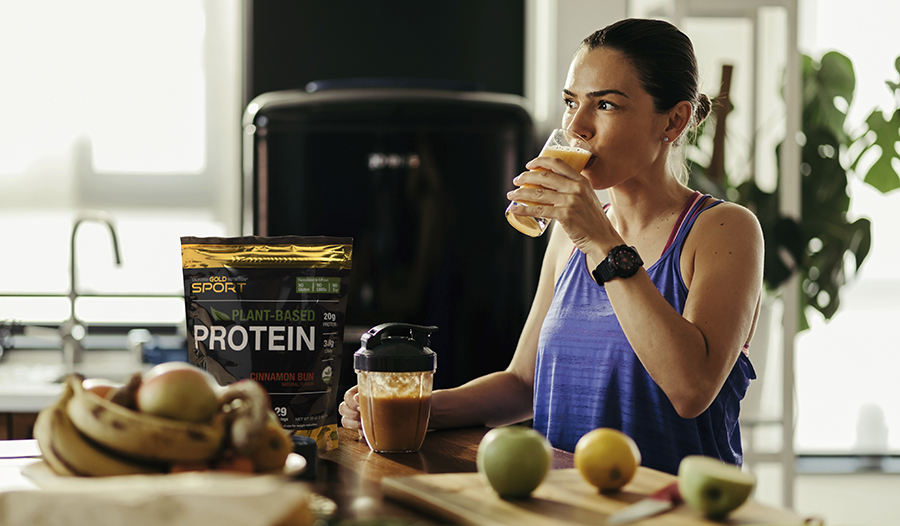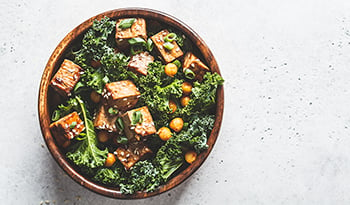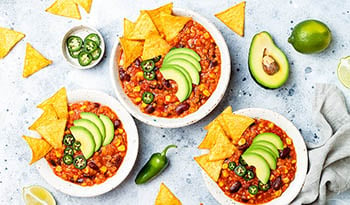5 Ways Vegetarians Can Get More Protein In Their Diet
DISCLAIMER:This blog does not intend to provide diagnosis...
- In this article:
- Different Types Of Vegetarian Eating Styles
- Why Is Protein Important For Vegetarian-Focused Eaters?
- 5 Ways Vegetarians Can Increase Their Protein
- Key Takeaways

When 2021 kicked off, my girlfriend and I started implementing more vegetarian-focused days of eating. Basically, we’ve been doing “Meatless Mondays,” which has helped me broaden my scope of eating and learn more about vegetarian eating styles.
We started implementing these meatless days for environmental reasons. For years, meat has been a staple in my diet for ensuring I hit my daily protein requirements. I’m a recreational powerlifter that is in the process of gaining weight, so hitting 200g of protein a day without one of my main staples has been a fun challenge, to say the least.
In this article, we’re going to dive into five ways vegetarian-focused eaters can consume more protein in their diet on a daily basis. Also, if you’re a weathered vegetarian and notice anything I missed or have additional tips, I’d love to hear from you!
Different Types Of Vegetarian Eating Styles
Before you read on, I do want to make it known that when excluding meat on these “Meatless Mondays” I was still consuming eggs and dairy products. There are multiple styles of vegetarian-focused eating and to ease into this style of eating, I made marginal changes as I went.
In this context, I eat in a style that is referred to as Lacto-ovo vegetarianism, which is a vegetarian eating style that avoids animal flesh but still consumes dairy products and eggs. There are also Lacto-vegetarians who consume dairy products but avoid eggs and meat products. Ovo vegetarians consume eggs and avoid meat-focused products, and then there are vegans, who avoid all foods derived from animals and animal products.
Why Is Protein Important For Vegetarian-Focused Eaters?
A constant struggle for vegetarians, and more specifically, newer vegetarians is consuming enough protein. Of the three macronutrients, protein is arguably the most important as it plays so many roles in our daily lives.
If you live an active lifestyle and want to grow and recover to your fullest potential, then protein will need to be towards the top of your hierarchy list. Protein plays an important role in muscle recovery, growth, immune system health, and countless other functions in the body.
If we’re not consuming enough protein on a regular basis, then we can end up losing valuable muscle mass, which is then followed by a slew of other issues. Diets lacking in protein can lead to decreases in one’s lean muscle mass, strength over time, a slowed metabolism (due to less muscle mass), and much more.
How To Transition To A Plant-Based Diet: Read more.
5 Ways Vegetarians Can Increase Their Protein
Below are five methods that I’ve been using to hit my daily protein goals when following our meatless eating days. These are also methods I’ve helped clients implement and methods that clients have shared with me that they use.

1. Consume More Protein Powder
One of the easiest ways to increase protein intake on a daily basis, despite your eating style is to utilize protein powder. There are countless types of protein powders on the market so no matter what style of vegetarian-focused eating you follow, there’s likely a protein powder that will match your needs well. Additionally, there are also more and more plant-based protein powders hitting the market as more active individuals move away from animal-focused products. If you do consume dairy, you can also try casein protein or whey protein.
It is worth noting that not everyone enjoys drinking straight protein shakes and that is totally okay. In this case, we have to be a bit more strategic with how we’re consuming and utilizing the protein powder based on the context of our needs and goals.
Some great examples that are worth exploring include:
- Protein oatmeal or overnight oats: Add a scoop of protein powder to your oatmeal.
- Protein-focused baking recipes: Utilize protein powder in baking recipes. There are a lot of great recipes out there for things like muffins, cookies, and so forth. Choose recipes that align with your dietary goals.
- Fruit smoothies: Add a scoop of protein powder to a blended fruit smoothie of your choosing. Some of my favorites include adding chocolate protein powder to a strawberry smoothie or banana and peanut butter smoothie.
When daily protein intake is the goal, consistency is the key. In this example, the goal is to find an option that suits your needs, tastes, and preferences best. There is no need to force a protein shake down when there are countless other ways to consume it.
2. Try Eating More Lentils And Beans
Lentils and beans have been a saving grace while being on the quest of hitting my daily protein goal. Lentils are part of the legume family and can be consumed in a variety of recipes. Generally, lentils are great go-to options for lunches and dinners.
How much protein is in one cup of lentils? There is around 18g of protein in one cup of lentils, which is a considerable amount for anyone trying to increase their daily protein intake. In addition, there are around 230 calories, 40g of carbs, and ~1g of fat in one cup of lentils.
3. Chickpea Pasta Can Be Worth Trying
Outside of lentils, chickpea pasta and other bean-based pasta types are also another great option worth exploring when protein intake is a concern. Chickpeas are also within the legume family and they offer a fair amount of protein when in the form of pasta.
For one serving of chickpea pasta, you can expect to consume around 190 calories, ~3-4g of fat, 32g of carbs, 12g of protein, and 5-7g of fiber. Overall, this is a pretty solid macronutrient spread for one serving of pasta.
4. Eggs And Egg Whites
Eggs and egg whites are another fantastic way to get enough protein in on a daily basis. The best part about eggs is that they’re cost-efficient, packed with nutrients (when consuming the yolk), can be used in countless recipes, consumed at every meal, and have a solid macronutrient spread.
If it’s not clear by now, I love eggs. If you’re trying to limit fat intake and still consume ample protein, then using egg white more regularly is an easy way to increase protein intake and keep caloric intake on the lower end.
My advice is to explore ways to consume eggs at least once or twice a day if protein intake is a concern. There are so many ways to prepare and consume eggs, find a means that works best with your preferences, goals, and needs.
5. Plant-Based Protein Bars
Another useful strategy for increasing daily protein intake when following a vegetarian-focused eating pattern is to explore plant-based protein bars. This strategy is best for those on the go in need of a quick protein-packed snack.
There are countless plant-based protein bars on the market, and I’d suggest always looking at the nutrition label before buying. Things like calories, macronutrients, sugar, and ingredients can vary greatly from bar to bar so explore options that suit your dietary needs best.
Key Takeaways
Vegetarian styles of eating are becoming more and more popular. As our knowledge around protein intake and active lifestyles continues to grow and expand, so does the need for consuming enough protein on a daily basis.
The five methods above can be incredibly useful for plant-based eaters that are trying to eat enough protein on a daily basis based on their health, nutrition, and fitness goals.
Top 6 Supplements Vegetarians May Need: Read more.

 By Jake Boly, CSCS
By Jake Boly, CSCS


